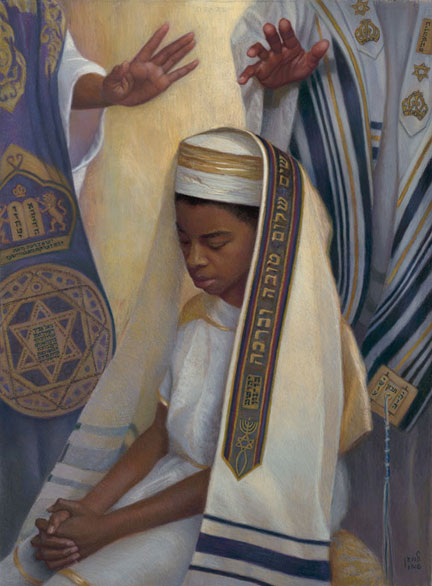“Joshua’s Blessing”
3/9
Pastel on paper
37″ × 27″
“Joshua’s Blessing” is a painting that has many layers of meaning. The subject of the painting is a boy named Joshua Enobakhare, whose parents are African with Hebrew roots on both sides of the family tree. The actual event that inspired me was a ceremony called a “Bar Baruch,” a combination of Jewish Bar Mitzvah and African traditions. Their custom is to have a coming of age ceremony at age 13, with invited family and friends, who each proclaim a blessing upon the child as a way of initiation into the community. Joshua’s mother, Remi, made African costumes, including Joshua’s tunic and turban, and added a Jewish tallit (prayer shawl). The ceremony was beautiful, powerful, and full of symbolism that inspired me.
I asked Joshua, and his mother and father, Remi and Ede Enobakhare, to come to my art studio to pose for a painting. There I re-created the pose of Joshua bowing on his knees, with both parents extending a hand of blessing. As they posed from life in my studio, the presence of the Holy Spirit could be felt, and my inspiration deepened.
As I worked on this piece, I began to think of the biblical Joshua, who was blessed by Moses. Moses transferred all of his authority to Joshua, who then ushered the children of Israel into the promised land. Two things set Joshua apart: the lengthy time he spent dwelling in the tabernacle, and Moses’ blessing him by laying his hands upon him.
The Bible has numerous instances of a father blessing his sons; one of the best known is that of Jacob (re-named Israel) blessing each of his sons. I began to meditate on the particular Bible verses that I might add into the painting, to tie it into the blessings from Jacob (Israel) upon his sons, and also relate it to the story of Joshua. I wanted to include scriptures describing attributes of blessing, such as strength, courage, wisdom, and understanding. I began to weave verses into the painting (eventually totaling 12), including Genesis 49:10, Gen 49:25–26, Deuteronomy 32:7, Deut 34:9, Proverbs 2:2, Pro 3:13, Pro 4:26, Pro 5:1, Job 12:13, and Joshua 1:7–8.
A 13th blessing/commandment is implied by the words on Joshua’s tallit. They are from the Amidah, the central prayer of Jewish liturgy. Embroidered on the tallit are the first four words from the 19th verse of the Amidah, “Establish/Grant Peace, Goodness, and Blessing,” which is about God establishing peace in Israel.



